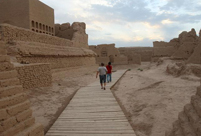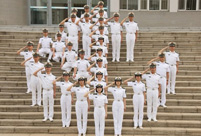 High speed train attendants receive training in Chongqing
High speed train attendants receive training in Chongqing
 Rare rainbow clouds seen in Fujian
Rare rainbow clouds seen in Fujian
 Small bracelet going global
Small bracelet going global
 Aerial Photography: Amazing Tianshan Mountains
Aerial Photography: Amazing Tianshan Mountains
 'Animals' in 2014 World Cup
'Animals' in 2014 World Cup
 Not afraid of death
Not afraid of death
 Chen Guangbiao ads on A15 of NYT to host charity luncheon for 1,000 poor and destitute Americans
Chen Guangbiao ads on A15 of NYT to host charity luncheon for 1,000 poor and destitute Americans
 Passionate bar babies and fans feel the charm of World Cup 2014
Passionate bar babies and fans feel the charm of World Cup 2014
 US aircraft carrier docks in HK, welcomes PLA aboard
US aircraft carrier docks in HK, welcomes PLA aboard
 Graduation season: 'Take graduation photos to mark our love'
Graduation season: 'Take graduation photos to mark our love'
BEIJING, June 25 -- For Chinese soccer fans, the possibility remains desperately slim for their men’s team to appear in the World Cup finals in any foreseeable years to come.
There is a joke that best illustrates such anticipated hopelessness: A fairy appears in China and promises one wish. Some people ask, “Can you kindly make the world peaceful and free of wars?”
The fairy seems fairly embarrassed and does not respond. Then some soccer fans ask, “Can you kindly send our men’s soccer team into the World Cup finals?”
The fairy says, “Well, let’s talk about world peace!”
Although the Chinese national team has failed to play in the soccer World Cup finals in Brazil — and they are not expected to make it any time soon — Chinese businesses have taken advantage of the extravaganza to make big money at least seemingly “big”.
A number of Chinese enterprises have pitched in for World Cup-related business. For example, the leading renewable energy firm Yingli Green Energy Holding Co Ltd, an official secondary World Cup sponsor, installed solar panels in some stadiums for the event.
Like other big companies, such as McDonald’s and Visa, Yingli’s name is displayed pitch-side during all the matches.
Broadcasting companies also reaped great benefits from advertising revenues during the World Cup finals. China’s major video website, Leshi, may see its advertising revenues hit $16 million and China Central Television, which has the exclusive right to broadcast World Cup matches in Chinese mainland, is expected to have its earnings surge by 50 percent compared with four years ago to hit $240 million this summer, according to investment research company Zacks.
Chinese companies have also been busy producing authorized products, such as the official match ball, named Brazuca, and countless commodities and souvenirs, such as mascots and national flags.
The Wagon Enterprise in Dongguan, Guangdong province, which makes World Cup products, has minted more than 1.5 million models of the World Cup trophy and 400 other items, according to a previous China Daily report.
Given the huge commercial benefits, researchers from Moody's Investors Services and others have claimed the Chinese economy could benefit more than Brazil’s from the World Cup.
A closer look at the role of the Chinese enterprises in the productions chains of World Cup-related products would hardly support such a conclusion.
Most of the Chinese companies profiting from the World Cup are from the manufacturing sector. As OEMs (original equipment manufacturers) of major international brands, their gains are pitiful compared with those brand owners.
For the 2010 World Cup in South Africa, Chinese companies that made the noisy, omnipresent horns called Vuvuzelas sold them to foreign dealers at the individual price of 2 yuan ($0.32. They were sold at 40 yuan a piece by street vendors in South Africa and were priced at as high as 100 Yuan in specialty stores in the country.
In other words, the Chinese manufacturer gained only a tiny slice of the valued added from making Vuvuzela.
This year, the Brazuca, the official ball under the Adidas brand made by a Shenzhen-based company called YaYork Plastic Products, is priced at 1,299 yuan, a company staff told China Daily in an earlier report.
How much of it would go to the manufacturer in Shenzhen remains unknown, but, based on previous experiences, it could be very miniscule.
An oft-cited case of Chinese manufacturers’ poor performance in global divisions of labor is that only about 2 percent of profits from the expensive Apple iPhone go to the Chinese OEM manufacturers.
In today’s manufacturing economy, most of the profits come from such links as design, brand, R&D and services. To gain more value added, enterprises must upgrade their R&D abilities, create their own brands and provide related services — much like how Apple does it.
Most Chinese companies are yet to go that far. The Chinese economy has become the world’s second largest, but its overall economic clout has been built on low-end manufacturing and consumption of resources.
China has become the factory of the world, but it is yet to be a real industrial power with complete and competitive production chains.
If China fares well in its efforts to restructure its economy and inspire technology and innovation, Chinese enterprises will hopefully play a more active role in the division of labor inherent to global manufacturing.
For now, only a small number of Chinese enterprises are climbing the ladder of global production.
Solar giant Yingli is, no doubt, one of the leading Chinese companies to shine at the World Cup.
Although the cost is as high as $17 million to become a secondary sponsor, it may be a good deal for Yingli as it makes its brand known to millions of consumers.
China’s electric vehicle makers have also won contracts to provide hybrid buses and trains to help soccer fans travel between stadiums and cities.
If the trend continues, more Chinese players —business players, not soccer players — may appear in the next World Cup finals.
 Silk Road, China's Grand Canal listed as World Heritage Sites
Silk Road, China's Grand Canal listed as World Heritage Sites Chinese 'Slumdog Millionaire'
Chinese 'Slumdog Millionaire' PKU students imitate famous paintings in real-person photos
PKU students imitate famous paintings in real-person photos Stewardesses in Brazilian soccer jerseys
Stewardesses in Brazilian soccer jerseys Puzhehei: land of idyllic beauty
Puzhehei: land of idyllic beauty Chinese navy fleet visits Cape Town, South Africa
Chinese navy fleet visits Cape Town, South Africa PLA naval cadets toss their hats at graduation ceremony
PLA naval cadets toss their hats at graduation ceremony Graduation photo ideas: reliable alumnus and happy alumna
Graduation photo ideas: reliable alumnus and happy alumna Super daddies in 2014 World Cup
Super daddies in 2014 World Cup Images of Xi'an: Part one
Images of Xi'an: Part one In Pictures: Female fans of World Cup
In Pictures: Female fans of World Cup Girl takes father’s portrait to travel the world
Girl takes father’s portrait to travel the world China's top 10 representative architectures
China's top 10 representative architectures Photo story: A day of 'mini girl'
Photo story: A day of 'mini girl' Top 20 hottest women in the world in 2014
Top 20 hottest women in the world in 2014 Day|Week|Month